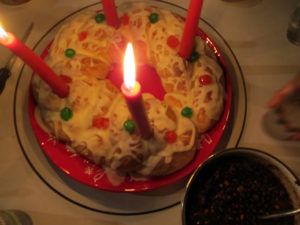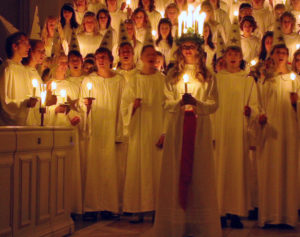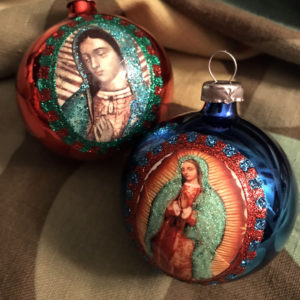Such a sacred act, lighting a candle. That concentrated energy in the spark of the wooden match striking the flint, a small explosion of illumination, lighting the wick that burns the tallow. Like many things of wonder, it is an act that is potentially dangerous, and yet, kept in control, a thing of extreme beauty. So many of our sacred nights here at our home are illuminated by candlelight. (Perhaps they all are sacred: for months now, since this time of isolation began, Seth has been lighting candles at the dinner table each night.)
As I write this today, it is the Feast of Our Lady of Guadalupe, and in the overnight hours as this day becomes the next, Sankta Lucia will arrive, too, with a wreath of candles upon her head, illuminating the dark cold night, this night that “walks with heavy steps.” I can picture all of the glass Guadalupe candles that are so ubiquitous in shops here in Lake Worth––from Botanica shops to the grocery store aisles––illuminated, too. Some folks are lighting Chanukah candles, and on the Advent wreath this Sunday, we illuminate two purples candles and the rose candle, too, for it is Gaudete Sunday, the Sunday of Advent where we add a measure of joy to our time of reflection. It is difficult to contain the joy that we know is coming with Christmas, and so the colors for this next week of Advent take on the joyful color of rosy pink, rather than somber purple.
And so here we are, practically midway through December already. The Feast of Our Lady of Guadalupe on the 12th of December is sacred to all the countries of Latin America, but most especially to Mexico. As the story goes, in 1531, a fellow named Juan Diego was on a hill near Mexico City and there he saw an apparition of a woman. She asked him to build a church in her honor there on the hill. She spoke to him in his native Nahuatl language and he recognized her, by the things she told him, as the Virgin Mary. And it was on 12th of December in that year that the iconic image of Our Lady of Guadalupe that we know so well miraculously appeared inside Juan Diego’s cloak: on one of his visits to the hill, Mary told Juan Diego to go to the barren top of the hill, but when he got there, he found it not at all barren but covered with roses, all in bloom. He and Mary gathered the roses and she arranged them inside his cloak. And on this, her feast day, Juan Diego opened his cloak before the bishop of Mexico City. When he did, the flowers all fell to the floor, revealing the image of the Virgin of Guadalupe. The bishop took it as a sign. The church was built, and the image from Juan Diego’s cloak, or tilma, hangs still inside the Basilica of Our Lady of Guadalupe on Tepeyac Hill, Mexico City.
The 13th, a Sunday this year, brings St. Lucy’s Day: the Feast of Santa Lucia in Italy (where Lucia is pronounced loo-chee-a) and Sankta Lucia in Sweden (where the C is soft: loo-see-a). Lucia is sacred to both countries; she was born and lived and died in Sicily, but––perhaps because the nights are so dark in Sweden in December––she was long ago taken up there and celebrated. Lucia = Light, and light is a precious commodity to come by near the Arctic Circle around this time of the approaching Midwinter Solstice.
In Italy, children will wake up in the morning to find tiny presents tied to their shoelaces, as long as they’ve left hay and carrots in their shoes before they went to bed, for Santa Lucia’s donkey. Santa Lucia follows St. Nicholas as the next of the Midwinter gift bearers. In Sweden, typically there are processions on this night in celebration of Sankta Lucia: in churches, in schools, in city streets, on national television. Each features a Lucia, donning a wreath of glowing candles upon her head, with scores of her attendants: boys and girls dressed all in white, each bearing a candle, and then the Star Boys, each carrying stars on poles and donning tall white conical caps. It is one of the most beautiful sights of these ever-darkening nights on the approach to the solstice. In homes, too, Lucia will come in the early morning darkness, wreath glowing upon her head, delivering strong coffee and saffron scented buns, lussekatter, to all in the household.
It is a time that gets jumbled up in our home (and perhaps many other places, too) with things both Italian and Swedish. Even the music for this night is jumbled, for the song that is sung throughout Sweden this night (click here to listen) is Italian in origin, an old Neapolitan melody, transformed and rewritten for a place where, at this darkest time of the year, the night is vast:
The night walks with heavy steps around farm and cottage.
Around the earth, forsaken by the sun, shadows are lowering.
Then into our dark house she treads with lighted candles,
Sankta Lucia, Sankta Lucia.
The night is vast and mute. Now here reverberate
in all silent rooms a rustle as of wings.
See, on our threshold stands––whiteclad, lights in her hair––
Sankta Lucia, Sankta Lucia.
“The darkness will soon take flight from the valleys of earth.”
Thus she a wonderful word to us speaks.
The day shall again, reborn, rise from a rosy sky,
Sankta Lucia, Sankta Lucia.
On Sunday morning, my sister will make her Santa Lucia wreath––a sweet yeast bread, braided and round, a never ending circle like the circle of days, dotted with candied cherries and illuminated with four red candles. Another simple yet delicious treat we have but once each year, and we’ll enjoy it tonight with coffee after dinner. This is our Santa Lucia way.
All of us here––my mom, my sister, Seth and me––we wish you light and peace on these sacred illuminated midwinter nights.
Image: My sister Marietta’s Santa Lucia Bread. I wish we could pour you some coffee and cut a slice for you!


